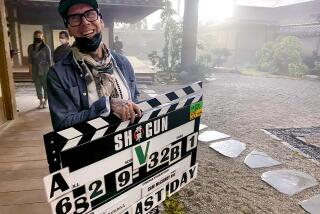Fortitude and ‘The First Grader’
Nganga Maruge, an 84-year-old man from a small village, made international headlines a few years ago when he decided to take the Kenyan government up on its offer to provide free primary education to everyone.
The former Mau Mau guerilla fighter put on a school uniform and showed up at his local primary school to get an education he was denied as a youth. His determination impressed the school principal, who enrolled him in a class full of 6-year-olds. But his unorthodox choice raised the hackles of parents and Kenyan school officials, who didn’t want to waste scarce resources on educating an old man.
Maruge’s struggle to get an education was the basis of a 2005 story in the Los Angeles Times by Robyn Dixon and inspired an independent film, “The First Grader,” which debuts Friday in theaters in Los Angeles and New York.
The independent movie, which has won audience awards at various film festivals, faced considerable odds to make it to theaters and is a rarity in the film industry: a movie about Africans featuring a mainly African cast and crew. “The First Grader” is being distributed by National Geographic’s entertainment unit, which also released the Oscar-nominated war documentary “Restrepo.”
“We look for films that are entertaining and if they can be informative, interesting and educational alongside — that’s ideal for us,” said Daniel Battsek, the former head of Miramax Films tapped to run National Geographic Films a year ago. “This fits very much into our sweet spot.”
The story’s journey to the big screen began six years ago when “Chronicles of Narnia” screenwriter Ann Peacock, who was born and raised in South Africa and lives in L.A., read about Maruge’s tale and was determined to turn it into a script. But L.A.-based producer Richard Harding, who also had deep ties to Africa (he was born in Sierra Leone), had already acquired the rights with his partner, Sam Feuer.
The pair eventually joined forces with Peacock and won the key backing of David Thompson, the former head of BBC Films, which helped to finance the project along with the U.K. Film Council.
To direct the film, Thompson turned to Justin Chadwick, with whom he had collaborated on the 2008 historical drama “The Other Boleyn Girl.”
Tudor England is a far cry from modern Kenya, but Chadwick was instantly drawn to the material and its message of education. “We had a chance to tell a story that was unusual for an African movie,” Chadwick said. “What struck me was this back story about this British-Kenyan colonial past that had been destroyed.”
Chadwick, however, knew little about Britain’s colonial history in Kenya and the brutal conflict with Mau Mau rebels in the 1950s. He traveled to Kenya to learn more about the country and met with Maruge in a hospice just before he died. “He was a real fighter,” Chadwick said. “You’d be sitting with him and he’d go, ‘I’m not old!’ He wanted to go for a walk.”
Producers considered filming in South Africa, which has a more established film industry, but Chadwick was determined to shoot the five-week, $10-million production in the country where the story was set with a mainly Kenyan cast and crew.
He spent weeks touring the country scouting the locations, eventually settling on a primary school in the Rift Valley in a remote area of western Kenya. He secured permission from village elders to film the school and its children, rather than relying on child actors brought in from elsewhere. Most had never seen a TV or a movie before. Lesson plans were designed and integrated into the film so that the children could act like they were really in class.
Developing a close bond between the school children and the teacher and principal, Jane Obinchu, was critical. Chadwick tapped British actress Naomie Harris, best known as Tia Dalma in “Pirates of the Caribbean: At World’s End,” for the part. Harris was surprised when Chadwick insisted she arrive two weeks before filming in early 2009 to build a rapport with the children.
“I’m glad he did,” she said. “When I first arrived I thought ‘Oh my God, they hate me. I’m never going to be able to have a relationship with these children.’ That was the most terrifying thing for me because they’re the heart of the film. They were so gentle and respectful that it took time for them to come out of their shells.”
For the part of Maruge, Chadwick held auditions in Africa, England, France and America, but struggled to find the right actor. One promising candidate failed to pass the required medical exam. Just two months before filming was set to begin, a crew member suggested Chadwick contact Oliver Litondo, who had small parts in movies and had worked as a TV news anchorman in 1970s.
“He was a gentle, beautiful man who had this warmth and intelligence,” Chadwick said.
Litondo said he was proud to tell his countryman’s story. “Here was this old man who rekindled that yearning to read and write,” he said. “For me, it was very inspiring. Whatever we try in life, we cannot fail if we have that determination — and this man had that determination.”
More to Read
The biggest entertainment stories
Get our big stories about Hollywood, film, television, music, arts, culture and more right in your inbox as soon as they publish.
You may occasionally receive promotional content from the Los Angeles Times.











